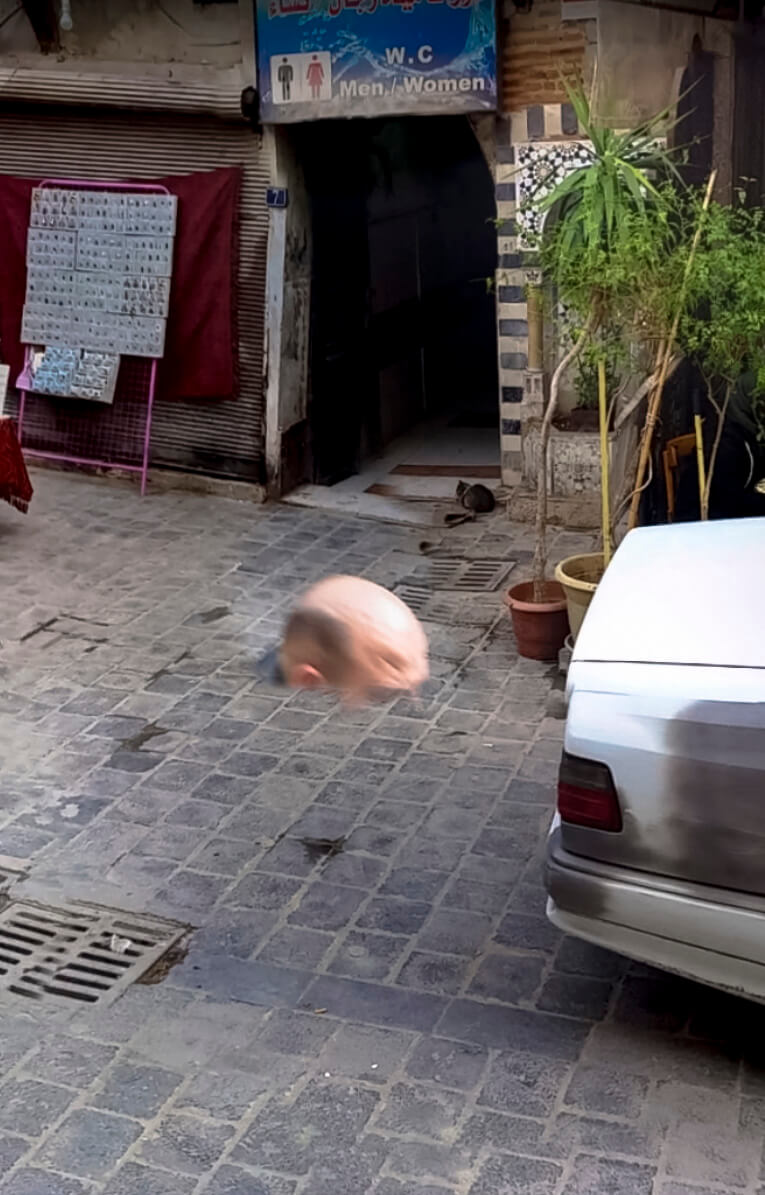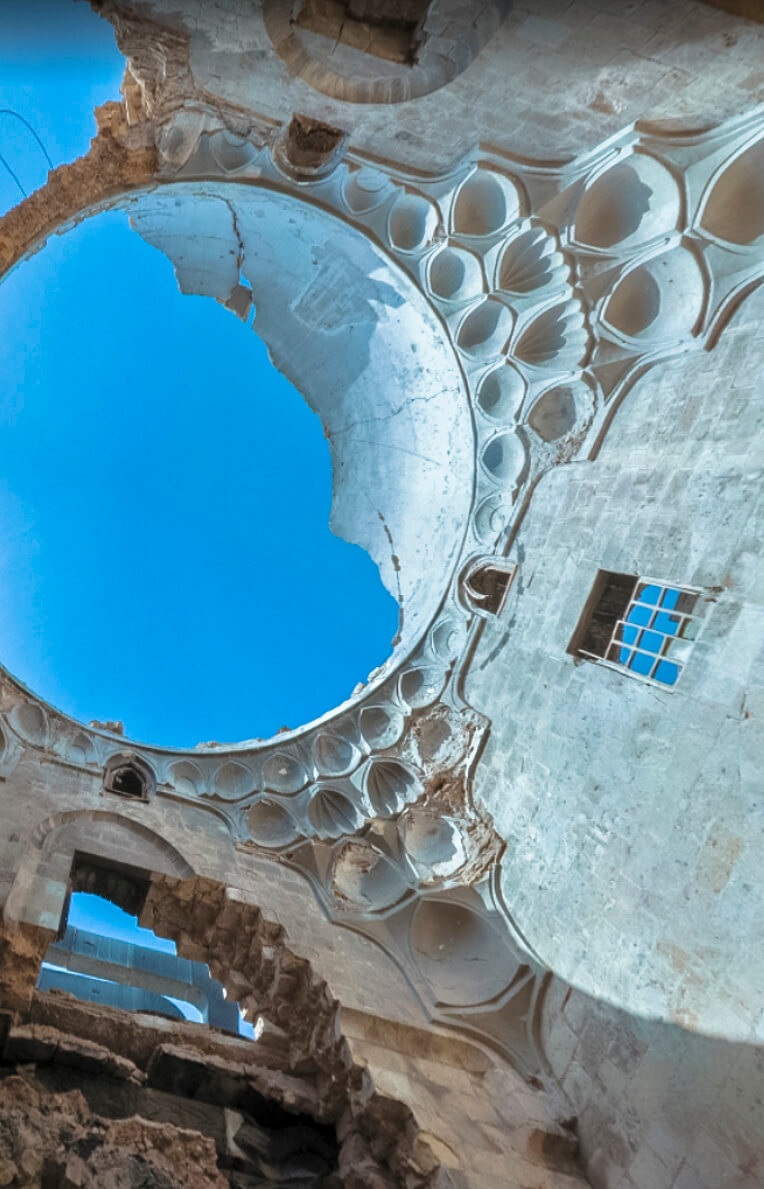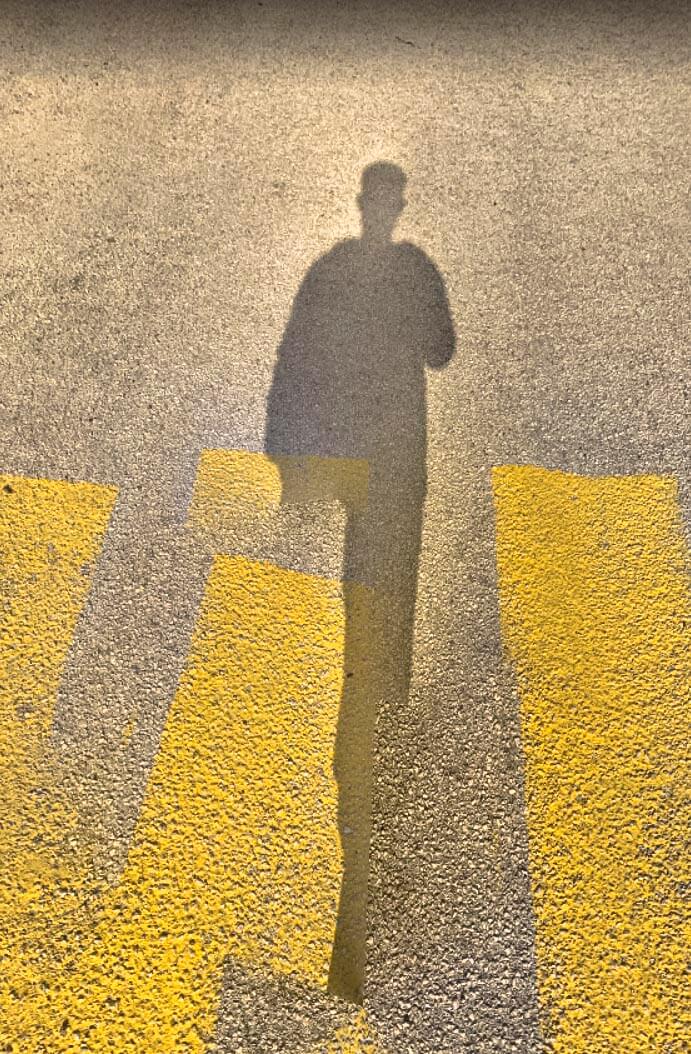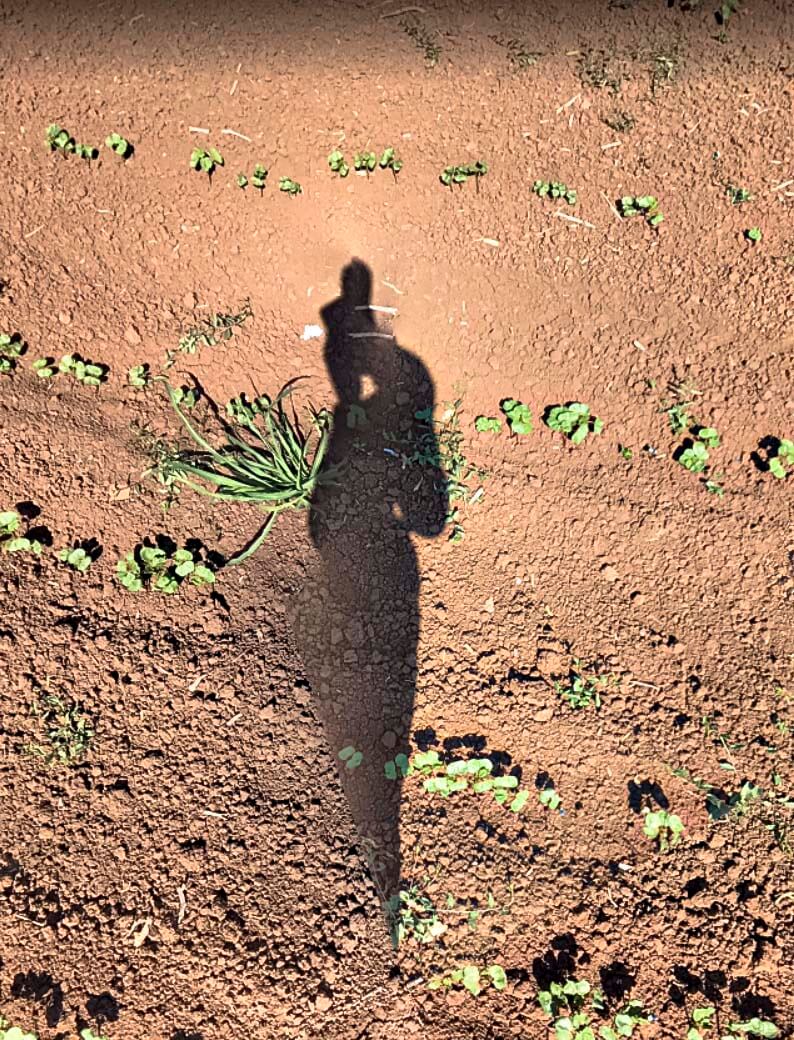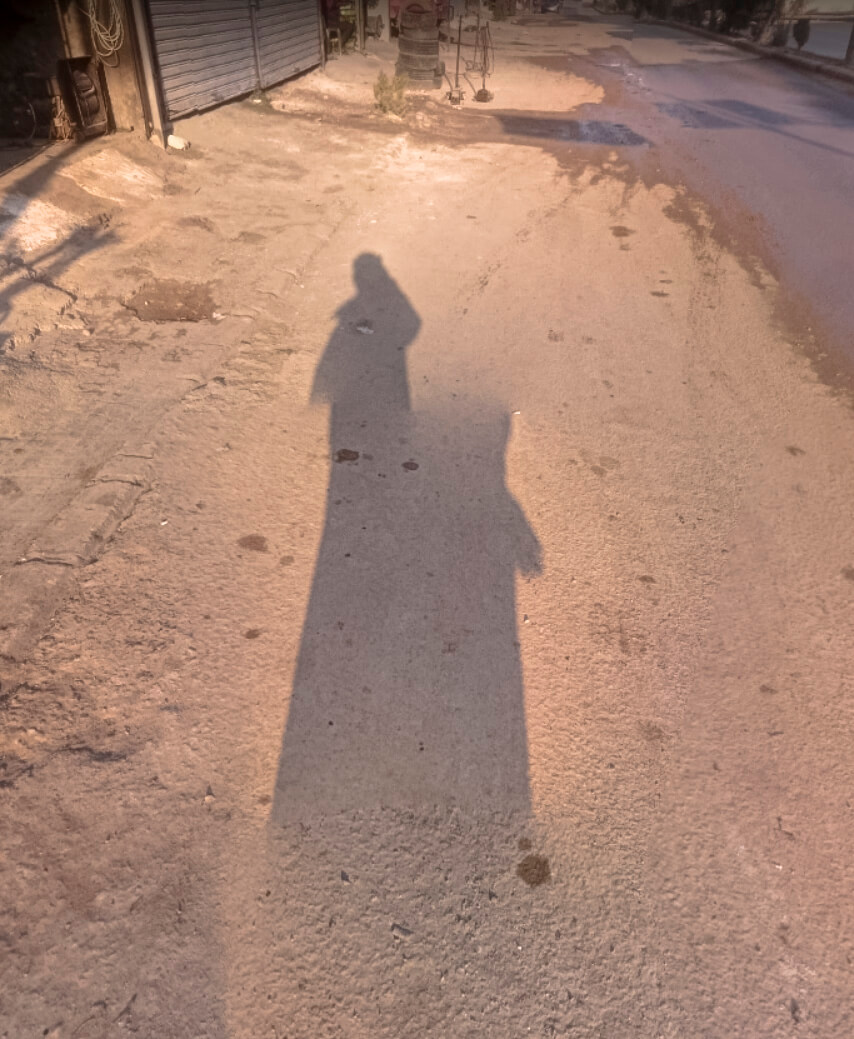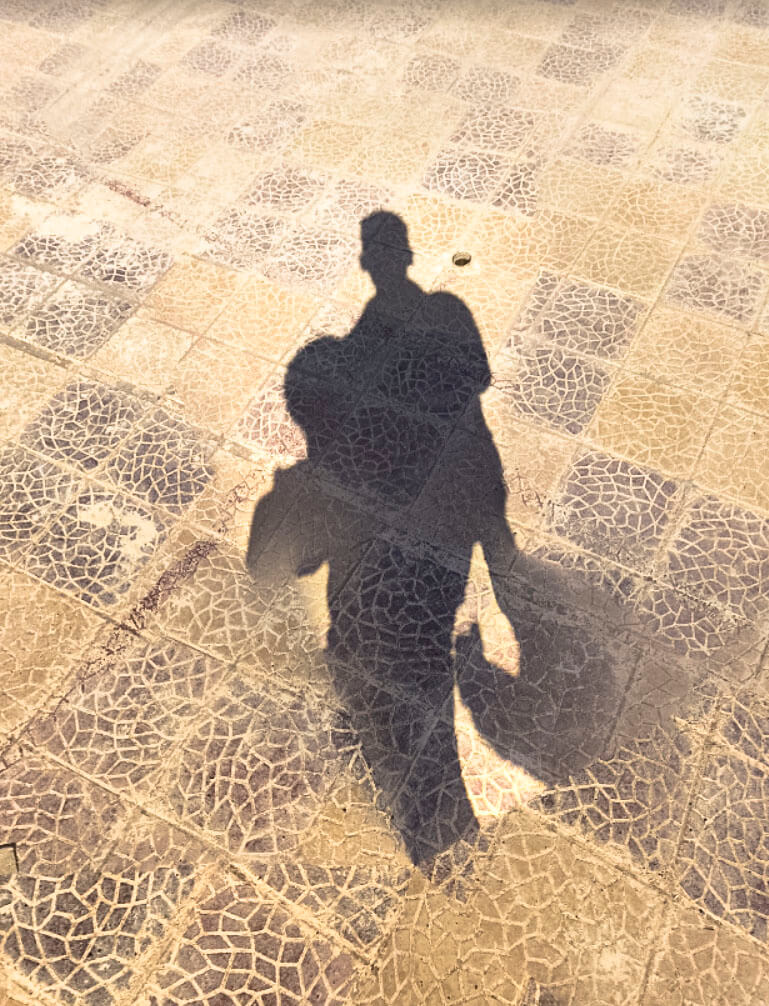The reportage stems from photographic research conducted using Google Earth. The investigation focuses on places where Westerners have limited access, filtered by the images that can be found on the web. The photographs portray the land and people of Syria between 2008 and 2020.
Let us try in a few instants to squeeze out the essence of what the East represents for us. Spirituality has an important place, the East is where we’ve often been to seek it. In the last three centuries in particular, since the Industrial Revolution, consumerism and the race to get rich have totally distorted our lives. So, the East is soul, the West matter. The kingdom of silence there, the realm of noise here. In Asia they seek the deep sense of life, which here is submerged and diminished as the hamsters spin on their wheels, as alienated modern human beings are buried under the oppression of things.
Let us continue this introspection, looking for everything that the real or imaginary East has laid down in our soul. There is an idea of primordial humanity – India as the origin of our populations, races, languages and civilization. China and Japan as the absolute Other, Buddhist and Confucian civilizations that a Polish pope defined as “godless religions”. Nihilist mysticism. Communion with nature.
Talking about nature, right down at the bottom of our collective subconscious there also lies an idea of the East as the land of erotic sensuality, where bodies are free to express themselves and take delight, not repressed by a sense of sin or sexophobic morality.
Not everything that is housed in the secret archives of our historical memory is positive. Also emerging from the bowels of the collective subconscious is “oriental despotism”, the idea that Asia is that part of the world where community prevails over the individual, even to the point of crushing him or her. Duties towards others come before rights. Authoritarian paternalism. Great empires that command over boundless masses, from whom they demand absolute obedience.
The East is all of this. Only recently has a new meaning been added: somewhere in Asia you’ve visited the workshop of modernity; dynamism, innovation and the construction of the future have moved there. For our generation, this last episode is the thinnest of layers, an impression that was only added a few years ago, onto the ancestral idea that we had of the East. (Our way of seeing things was very different at the time of the Renaissance, half a millennium ago, when Asia had invented everything before us).
The East is not just a geographical place, but a place of the soul too. Of our soul: we built it. We’ve been painting this picture for over two thousand years, we’ve made a myth of it, a cultural construct. Starting from Homer and Alexander the Great. The formidable allure that it holds for us is highly understandable. The sun rises in the East every morning, hordes of people arrived here from there and invaded, conquered and civilized us. Sometimes we got our own back, going to colonize them ourselves; but in the long period of three millennia the tide mainly flowed in the other direction.
For obvious reasons: Europe doesn’t exist, geographically it’s the little peripherical offshoot of an enormous landmass that is the Asian continent. Open up an atlas and look how tiny Europe is. It’s also indistinguishable, inseparable. Nothing really divides us from our Mother Earth which is the Asian block. In fact, Eurasia is the only definition that makes sense. The concentration of humans has always been greater in the East.
(There was the odd invasion from the South with the first African hominids; the Carthaginians; from the North with the Vikings, the Normans, the Swabians, but just crumbs compared to the peoples from the steppes who whipped over the great plains of Mongolia and central Asia to conquer us with implacable regularity).
For the very reason that we’re small, confined to this European peninsula squeezed between the Mediterranean, Atlantic and Nordic seas, we started to form an idea of the East based on disproportion. Their immensity was to transform into a negative value. The great battles of antiquity, between Greeks and Persians, opposed “our” – few, free and strong – men to some genuinely sweeping tides of human beings. Recently even Hollywood made a stereotype of it, renewing an ancestral myth for the contemporary masses. The idea already came to the ancient Greeks that we are individuals, capable of heroism, and they were masses. We are born with an idea of rights and freedoms; the Orientals are disciplined and obedient armies, dominated by semi-god emperors, with absolute power over their subjects.
I’ve caused some geographical confusion: what East am I talking about? China is the most ancient and biggest part, that’s for sure. With its cultural filiations – Japan, Korea, Vietnam and Myanmar, which also belong to the two parallel Buddhist and Confucian traditions – China is the furthermost and densest extreme of Asia. But we discovered it late. The real, direct meeting between us and Chinese civilization happened at the time of Marco Polo (that is, the day before yesterday, at the end of the thirteenth century). Before that, most of our relations with the Chinese were indirect, managed by midway civilizations such as Persia and India. When we were Hellenic or Latin, the East meant Asia Minor. It started with the Turkish coast. Ideas and values, scientific discoveries and products, silk and spices, for a long time arrived here from the remote China thanks to the mediation of the Near East. This is why the idea of the East already starts to take shape in Istanbul; even though half of that city is in Europe. Indeed, the Turks came from China; at the outset the Ottomans were one of those peoples of the steppes who crossed the whole of Asia to venture as far as us.
Many of these midway civilizations were conquered by Islam from the seventh century on. A cumbersome presence in many senses. From the Arab or Mongolian conquests up to the end of the Ottoman Empire, the Asia that bore down on us Europeans was first of all the Muslim part. The Islamic question tinges our first religious approach to China with positive prejudices: the Christian missionaries went to seek an ally in the Celestial Emperor in the wars against the Sultans. The first shreds of information that we received from the Far East were sympathetic translations of Buddha and Confucius, for exquisitely diplomatic reasons. It is surprising to reread the Jesuits’ battle in defence of “Chinese rites” today.
Before the East meant for us spirituality, ascetism and detachment from earthly things, it became the place of modernity, wisdom, culture and good government. Part of the French Enlightenment – Voltaire first of all – admired the Celestial Empire. Important discoveries had come from there, for example, the navigation tools which had allowed the exploration of new continents. Printing and gunpowder were also Chinese before they became European. Voltaire, in particular, respectfully bowed down before the institution of the examinations to qualify as a mandarin: imperial China selected the top echelons of its public administration on the basis of public, meritocratic competitions, while in the French ancien régime the government roles were sold to the highest bidder or inherited by the descendants of nobility.
The kingdom of silence, the spirit, transcendency, the East became so for us after the first Industrial Revolution. It was above all German Romanticism during the nineteenth century that imposed two convictions: that India was the primordial cradle of all our civilizations; that Buddhism was an antidote to the evils of modernity. Asia was reinvented, rediscovered and relaunched in a new light: after the German Romantics, Nietzsche and Schopenhauer arrived. Then Hermann Hesse with Siddharta, a novel of self-discovery that has formed generations of young Europeans and Americans. A thread joins Siddharta to the Beat poets of the 1950s; to the San Francisco Summer of Love (1967) where a whole generation of young Americans discovered the sitar of Ravi Shankar and yoga; to The Beatles’ journey to India to the source of the Ganges the year after.
Even further east, Japan influences us in more subtle ways. It is the minimalism of its architecture, its design, that conquered for example Steve Jobs (founder of Apple) and with him the technological world of California’s Silicon Valley. Together with sushi or the vegan diet, “zen” has been a fashionable adjective in everyday language in America since the 1990s. A way of conceiving life. The idea is that behind the universe of Japanese forms there is also a system of values, where we can find a lost serenity.
But it is Japan that forces us to deal with a topsy-turvy reality; it’s a paradox that China experiences in an even more evident manner. Today these two civilizations (which only also became “nations” to mimic a Western invention) have reached or overtaken us in many fields of technology and the economy. We tend to place the Japanese economic miracle in the 1950s; in reality, it started in the second half of the nineteenth century with the Meiji Reform. Then Japan had decided to imitate the West in many fields. Its models were British industry and the Prussian army. It managed so well that it was the first Asian power in the modern age to defeat a European empire, tsarist Russia (1905). The Japanese economic miracle was followed by those in South Korea, Singapore and Taiwan. All with the same recipe: take the best from the West in the economic, scientific and technological fields. Last, it was China’s turn. The country repeated the exploit too, on an immense scale. It copied many ingredients of American capitalism; assimilated our town planning, our consumer models, even our diet. For the most part, acupuncture and traditional medicine were abandoned to instead offer hospitals with Western equipment. In many fields, the Chinese boom of the last 30 years has simply been the grafting of a global Western model onto a population of 1 billion 400 million people, who already had trade and business traditions of their own. But this throws us. While we followed a myth of the East, they built themselves a paragon of the West. They studied us, often with more attention and more humility than we study them. The result is dizzying. What has happened to the East that we cherished for generations? Is it buried under layers of “Westernism” that have disfigured and spoilt their civilizations? Or does something profoundly different remain between us? What are our true identities?
They’re questions we’ve been asking for two thousand years.
It’s not positive values on one side and negative ones on the other. A game of overturned mirrors, of manipulated images has been going on between us and them for two millennia. West and East form an idea of each other through contrast, which can sometimes be imaginary. The identity that we give to the Other, due to a quirk of history, at times really does contribute to the image that the Orientals have of themselves. But it’s a game where perhaps the roles are being flipped, and soon it will be the East that’s telling us who we were, and who we are.
(This text is freely adapted by the author from his latest book Oriente e Occidente, Einaudi 2020).
